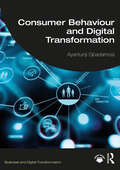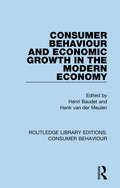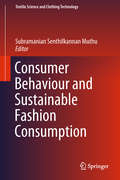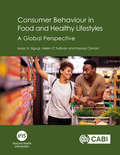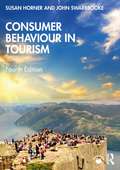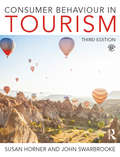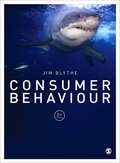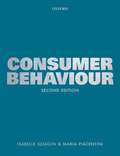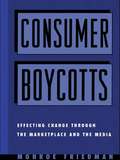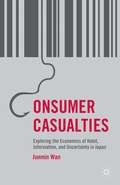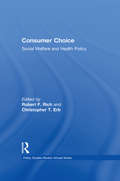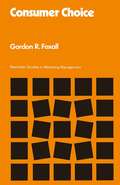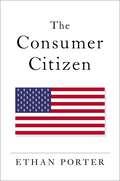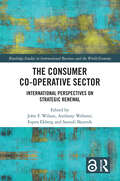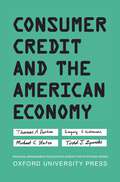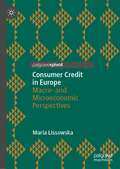- Table View
- List View
Consumer Behaviour and Digital Transformation (Business and Digital Transformation)
by Ayantunji GbadamosiThis comprehensive textbook explores how technological developments and emerging technologies impact on, and engage with, consumer behaviour and decision making globally. The book will enable readers to develop a coherent understanding of the basic underpinnings of consumer behaviour as they relate to individual and group-oriented consumption decisions, offering insight into how consumer behaviour, contemporary real-life situations, and digital technology are inextricably linked.Key learning objectives, exercises and activities, boxed examples and analytical frameworks facilitate and enrich students’ learning. Each chapter includes ‘pause, plan, and practice (PPP)’ activities, as well as real-life case studies exploring digital consumption, digital consumer experiences, and digital trends across industries, from global companies such as Nike and McDonald’s to the digital transformation of SMEs. Combining a thorough examination of traditional theory with a fresh approach to the impact of digital transformation on consumer behaviour, this textbook should be core reading for advanced undergraduate and postgraduate students studying Consumer Behaviour, Consumer Psychology, Customer Experience Management, and Digital Marketing.This book will be accompanied by online resources for the use of instructors, including PowerPoint slides and a test bank.
Consumer Behaviour and Digital Transformation (Business and Digital Transformation)
by Ayantunji GbadamosiThis comprehensive textbook explores how technological developments and emerging technologies impact on, and engage with, consumer behaviour and decision making globally. The book will enable readers to develop a coherent understanding of the basic underpinnings of consumer behaviour as they relate to individual and group-oriented consumption decisions, offering insight into how consumer behaviour, contemporary real-life situations, and digital technology are inextricably linked.Key learning objectives, exercises and activities, boxed examples and analytical frameworks facilitate and enrich students’ learning. Each chapter includes ‘pause, plan, and practice (PPP)’ activities, as well as real-life case studies exploring digital consumption, digital consumer experiences, and digital trends across industries, from global companies such as Nike and McDonald’s to the digital transformation of SMEs. Combining a thorough examination of traditional theory with a fresh approach to the impact of digital transformation on consumer behaviour, this textbook should be core reading for advanced undergraduate and postgraduate students studying Consumer Behaviour, Consumer Psychology, Customer Experience Management, and Digital Marketing.This book will be accompanied by online resources for the use of instructors, including PowerPoint slides and a test bank.
Consumer Behaviour and Economic Growth in the Modern Economy (Routledge Library Editions: Consumer Behaviour)
by Henri Baudet Henk Van Der MeulenThese essays show that industrialisation and fast economic growth have changed not only the broad material environment, but have also had a very important impact on basic food consumption. The introductory chapter takes a theoretical view and tries to establish the interrelationship between economic forces and social habits. The other contributors analyse how the experience of Europe, Japan and North America fit this general explanation and they demonstrate how cultural and regional differences have shaped the development of consumer behaviour and patterns of consumption over the last two centuries.
Consumer Behaviour and Economic Growth in the Modern Economy (Routledge Library Editions: Consumer Behaviour)
by Henri Baudet Henk Van Der MeulenThese essays show that industrialisation and fast economic growth have changed not only the broad material environment, but have also had a very important impact on basic food consumption. The introductory chapter takes a theoretical view and tries to establish the interrelationship between economic forces and social habits. The other contributors analyse how the experience of Europe, Japan and North America fit this general explanation and they demonstrate how cultural and regional differences have shaped the development of consumer behaviour and patterns of consumption over the last two centuries.
Consumer Behaviour and Sustainable Fashion Consumption (Textile Science and Clothing Technology)
by Subramanian Senthilkannan MuthuThis book analyses the importance of consumer behaviour in sustainable fashion and consumption. Consumer behaviour plays a major role in sustainability, and when it comes to textile products, a number of studies have shown that for certain product categories, consumer behaviour during use and disposal stages influences the entire life cycle impacts of the product more than the raw material and manufacturing stages. However green the production, the overall sustainability of a product depends on the consumers who use and dispose of it.
Consumer Behaviour in Food and Healthy Lifestyles: A Global Perspective
by Dr Isaac K Ngugi Helen O'Sullivan Dr Hanaa OsmanThis book is an essential resource exploring the concepts, theories and methods in consumer behaviour specifically applicable to the food and drink sector. Drawing examples from all continents, it provides you with accessible coverage and a truly global perspective of the particular characteristics of this industry. It offers clear explanations and applications of theoretical concepts, using specialised case studies and examples; features an introduction, learning objectives and summary in each chapter to hone your reading and revision; and provides you with companion online material including notes and self-assessment questions. This important new book is the perfect guide for students studying consumer behaviour or experience in food and drink as part of courses in agricultural or agribusiness management and economics, hospitality and tourism, business studies, food science and nutrition, or generic marketing and consumer studies.
Consumer Behaviour in Tourism
by Susan Horner John SwarbrookeNow fully revised and updated, the fourth edition of this bestselling text provides students with a vital understanding of the nature of tourism and contemporary tourist behaviour. It also shows them how this knowledge can be used to manage and market tourism effectively in a variety of sectors of tourism including tour operations, hospitality, visitor attractions, transport, retail travel, cruising and airlines. This fourth edition has been updated to include: new material on the impact of Information Communication Technologies (ICT) developments in tourism including social media, AR and VR, the links between climate change, sustainability and tourist behaviour, and the impact of crises and natural disasters on tourism and the cruise industry thirty brand new international case studies about topical issues such as Airbnb, travel blogs, overtourism, Covid-19, the flight-shaming movement, wellness tourism, hunting and tourism, terrorism, dark tourism, the solo traveller, volunteer tourism, second home ownership, music festivals, pilgrimage tourism, film- and TV-induced tourism, and tourism in Antarctica new online resources including PowerPoint slides and a case archive. Each chapter features conclusions, discussion points, essay questions and exercises to help tutors direct student-centred learning and allow students to check their understanding of what they have read. This book is an invaluable resource for students studying tourism.
Consumer Behaviour in Tourism
by Susan Horner John SwarbrookeNow fully revised and updated, the fourth edition of this bestselling text provides students with a vital understanding of the nature of tourism and contemporary tourist behaviour. It also shows them how this knowledge can be used to manage and market tourism effectively in a variety of sectors of tourism including tour operations, hospitality, visitor attractions, transport, retail travel, cruising and airlines. This fourth edition has been updated to include: new material on the impact of Information Communication Technologies (ICT) developments in tourism including social media, AR and VR, the links between climate change, sustainability and tourist behaviour, and the impact of crises and natural disasters on tourism and the cruise industry thirty brand new international case studies about topical issues such as Airbnb, travel blogs, overtourism, Covid-19, the flight-shaming movement, wellness tourism, hunting and tourism, terrorism, dark tourism, the solo traveller, volunteer tourism, second home ownership, music festivals, pilgrimage tourism, film- and TV-induced tourism, and tourism in Antarctica new online resources including PowerPoint slides and a case archive. Each chapter features conclusions, discussion points, essay questions and exercises to help tutors direct student-centred learning and allow students to check their understanding of what they have read. This book is an invaluable resource for students studying tourism.
Consumer Behaviour in Tourism
by John Swarbrooke Susan HornerNow fully revised and updated, the third edition of this bestselling text provides students with a vital understanding of the nature of tourism and contemporary tourists behaviour in political, social and economic context and how this knowledge can be used to manage and market effectively in a variety of tourism sectors including: tourism operations, tourist destinations, hospitality, visitor attractions, retail travel and transport. This third edition has been updated to include: New material on the impacts of IT on research and marketing communications, the rise and influence of social media and virtual technology, the growth in the interest of sustainable tourism products including slow food, the experience economy and new consumer experiences including fulfilment. New international case studies throughout including growth regions such as the Middle East, Russia, Europe, China, India and Brazil. New companion website including Power point slides and a case archive. Each chapter features conclusions, discussion points and essay questions, and exercises, at the end, to help tutors direct student-centred learning and to allow the reader to check their understanding of what they have read. This book is an invaluable resource for students following tourism courses.
Consumer Behaviour in Tourism
by John Swarbrooke Susan HornerNow fully revised and updated, the third edition of this bestselling text provides students with a vital understanding of the nature of tourism and contemporary tourists behaviour in political, social and economic context and how this knowledge can be used to manage and market effectively in a variety of tourism sectors including: tourism operations, tourist destinations, hospitality, visitor attractions, retail travel and transport. This third edition has been updated to include: New material on the impacts of IT on research and marketing communications, the rise and influence of social media and virtual technology, the growth in the interest of sustainable tourism products including slow food, the experience economy and new consumer experiences including fulfilment. New international case studies throughout including growth regions such as the Middle East, Russia, Europe, China, India and Brazil. New companion website including Power point slides and a case archive. Each chapter features conclusions, discussion points and essay questions, and exercises, at the end, to help tutors direct student-centred learning and to allow the reader to check their understanding of what they have read. This book is an invaluable resource for students following tourism courses.
Consumer Behaviour (PDF)
by Jim BlytheElectronic Inspection Copy available for instructors here Why do you choose the things you buy - such as this textbook, a smartphone or an item of clothing? How often, where, and instead of what? What do you consider a boring necessity or a fun luxury? What do you do with products once you've purchased them? When do you decide to chuck them and why? As a consumer you make conscious and unconscious decisions, nonstop, every day of your life. This is Consumer Behaviour! This friendly, lively full colour text will support you through your course and help you to get the best possible grade for future employment. It even has How to Impress Your Examiner boxes in each chapter. There are lots of case studies along the way from global brands such as Facebook, Apple and Amazon Kindle, and Consumer Behaviour in Action boxes in every chapter to show you how it works in the real world. If you want to be top of the class you can push yourself that little bit further by reading the Challenging the Status Quo asides which will help your critical thinking and problem solving skills. These are key skills that employers look for in graduates, so practicing now will help set you apart from the pack and boost your employability. You could also dip into the Further Reading resources to help you with essays and exam revision - using these is a sure route to better grades. Visit the companion website www. sagepub. co. uk/blythe for extra materials including multiple choice questions to test yourself and Jim's pick of Youtube videos that make the examples in each chapter come alive! 9781446266441 9781446290323 9781446276334
Consumer Behaviour (PDF)
by Isabelle Szmigin Maria PiacentiniClearly written, fun, imaginative and covers essential consumer behaviour theory and practice very well. Great additional materials, excellent academic quality and very practical. I love this book! ― Catherine Canning, Senior Lecturer in the Department of Business Management at Glasgow Caledonian University An excellent core text that will be a great companion for UG students at all levels, offering a combination of practitioner and academic examples that will help students understand key topics and prepare for research. ― James Blackmore-Wright, Senior Lecturer in Marketing at the University of Northampton Full of recent, relevant, meaningful examples which will greatly appeal to 21st century students of the subject. Well-written, accessible, highly readable and full of useful, contemporary learning aids. ― Donald McFetridge, Lecturer in Business Studies, University of Ulster Simply a must for all undergraduate and taught postgraduate students studying consumer behaviour. ― Jonathan Elms, Senior Lecturer in Marketing and Retail at the University of Stirling and Associate Editor of the Journal of Consumer Behaviour
Consumer Boycotts: Effecting Change Through the Marketplace and Media
by Monroe FriedmanFirst published in 1999. Routledge is an imprint of Taylor & Francis, an informa company.
Consumer Boycotts: Effecting Change Through the Marketplace and Media
by Monroe FriedmanFirst published in 1999. Routledge is an imprint of Taylor & Francis, an informa company.
Consumer Casualties: Exploring the Economics of Habit, Information, and Uncertainty in Japan
by J. WanJunmin Wan takes a two prong approach to analysing this pressure in Japan in his new volume Consumer Casualties. He first clarifies the consumer preference for habit to identify useful approaches toward solving a number of economic issues, such as gambling and other addictive practices.
Consumer Choice: Social Welfare and Health Policy
by Christopher T. Erb"The United States health care system is unique among those of other developed economies--most significantly because health care is not a legal right in the United States. Instead, it is considered an employee benefit and a privilege, unless one is over age 65 or of low income. The United States is the only developed country without some form of universal health care.Contributors to this volume represent an interdisciplinary group of academics, practitioners, and service delivery providers. The volume begins with a general examination of the politics of health and social welfare in the United States. It then focuses on the importance and role of consumers in the U.S. economy, and dilemmas associated with promoting consumer choice. It explores policy issues and challenges in three specific areas: controlling health care costs and protecting choice with respect to health care, the major challenges to informed choice in health care, and barriers to effective health care service delivery. Contributors explore changes and reforms that have been introduced within public and privately financed systems over the past ten years.Consumer Choice examines in a timely and efficient manner critical social and health policy issues--nationally and internationally--and the major challenges that face informed choice in health care and social policy. Policymakers, health care officials, and medical personnel in the United States and other countries will find this volume highly informative."
Consumer Choice: From Behavior To Action, From Action To Agency (pdf) (Studies in Marketing Management)
by Gordon R FoxallConsumer Choice: Social Welfare and Health Policy
by Robert F. Rich & Christopher T. Erb"The United States health care system is unique among those of other developed economies--most significantly because health care is not a legal right in the United States. Instead, it is considered an employee benefit and a privilege, unless one is over age 65 or of low income. The United States is the only developed country without some form of universal health care.Contributors to this volume represent an interdisciplinary group of academics, practitioners, and service delivery providers. The volume begins with a general examination of the politics of health and social welfare in the United States. It then focuses on the importance and role of consumers in the U.S. economy, and dilemmas associated with promoting consumer choice. It explores policy issues and challenges in three specific areas: controlling health care costs and protecting choice with respect to health care, the major challenges to informed choice in health care, and barriers to effective health care service delivery. Contributors explore changes and reforms that have been introduced within public and privately financed systems over the past ten years.Consumer Choice examines in a timely and efficient manner critical social and health policy issues--nationally and internationally--and the major challenges that face informed choice in health care and social policy. Policymakers, health care officials, and medical personnel in the United States and other countries will find this volume highly informative."
The Consumer Citizen
by Ethan PorterCitizens are asked to buy, and asked to consider to buy, goods of all sizes and all prices, nearly all of the time. Appeals to political decision-making are less common. In The Consumer Citizen, Ethan Porter investigates how the techniques of everyday consumer experiences can shape political behavior. Drawing on more than a dozen original studies, he shows that the casual conflation of consumer and political decisions has profound implications for how Americans think about politics. Indeed, Porter explains that consumer habits can affect citizens' attitudes about their government, their taxes, their politicians, and even whether they purchase government-sponsored health insurance. The consumer citizen approaches government as if it were just an ordinary firm. Of course, government is not an ordinary firm---far from it---and the disjunction between what government is, and the consumer apparatus that citizens bring to bear on their evaluations of it, offers insight into several long-unanswered questions in political behavior and public opinion. How do many Americans make sense of the political world? The Consumer Citizen offers a novel answer: By relying on the habits and tools that they learn as consumers.
CONSUMER CITIZEN C
by Ethan PorterCitizens are asked to buy, and asked to consider to buy, goods of all sizes and all prices, nearly all of the time. Appeals to political decision-making are less common. In The Consumer Citizen, Ethan Porter investigates how the techniques of everyday consumer experiences can shape political behavior. Drawing on more than a dozen original studies, he shows that the casual conflation of consumer and political decisions has profound implications for how Americans think about politics. Indeed, Porter explains that consumer habits can affect citizens' attitudes about their government, their taxes, their politicians, and even whether they purchase government-sponsored health insurance. The consumer citizen approaches government as if it were just an ordinary firm. Of course, government is not an ordinary firm---far from it---and the disjunction between what government is, and the consumer apparatus that citizens bring to bear on their evaluations of it, offers insight into several long-unanswered questions in political behavior and public opinion. How do many Americans make sense of the political world? The Consumer Citizen offers a novel answer: By relying on the habits and tools that they learn as consumers.
The Consumer Co-operative Sector: International Perspectives on Strategic Renewal (Routledge Studies in International Business and the World Economy)
by John F. Wilson Anthony Webster Espen Ekberg Samuli SkurnikGlobally, consumer co-operation has experienced a difficult period since the 1970s. Large scale failures in France, Germany and Austria were accompanied by loss of market share in the UK (including the failure of the Scottish Co-operative Wholesale Society and its takeover by its English counterpart). Even in the Nordic countries, where consumer co-operation has always been more robust, new challenges from the non-co-operative sector had to be confronted. How did co-operative organizations in different countries cope with these challenges? What were the processes of strategic renewal that they undertook? How successful were they? These are the key questions that the collection will address, culminating in an analysis by the editors of the effectiveness of strategic renewal in the co-operative sector. This book is a study of strategic renewal in the consumer co-operative sector, using eleven international case-studies to demonstrate how the concept has been applied over the last fifty years.
The Consumer Co-operative Sector: International Perspectives on Strategic Renewal (Routledge Studies in International Business and the World Economy)
by John F. Wilson Anthony Webster Espen Ekberg Samuli SkurnikGlobally, consumer co-operation has experienced a difficult period since the 1970s. Large scale failures in France, Germany and Austria were accompanied by loss of market share in the UK (including the failure of the Scottish Co-operative Wholesale Society and its takeover by its English counterpart). Even in the Nordic countries, where consumer co-operation has always been more robust, new challenges from the non-co-operative sector had to be confronted. How did co-operative organizations in different countries cope with these challenges? What were the processes of strategic renewal that they undertook? How successful were they? These are the key questions that the collection will address, culminating in an analysis by the editors of the effectiveness of strategic renewal in the co-operative sector. This book is a study of strategic renewal in the consumer co-operative sector, using eleven international case-studies to demonstrate how the concept has been applied over the last fifty years.
Consumer Credit and the American Economy (Financial Management Association Survey and Synthesis)
by Thomas A. Durkin Gregory Elliehausen Michael E. Staten Todd J. ZywickiConsumer Credit and the American Economy examines the economics, behavioral science, sociology, history, institutions, law, and regulation of consumer credit in the United States. After discussing the origins and various kinds of consumer credit available in today's marketplace, this book reviews at some length the long run growth of consumer credit to explore the widely held belief that somehow consumer credit has risen "too fast for too long." It then turns to demand and supply with chapters discussing neoclassical theories of demand, new behavioral economics, and evidence on production costs and why consumer credit might seem expensive compared to some other kinds of credit like government finance. This discussion includes review of the economics of risk management and funding sources, as well discussion of the economic theory of why some people might be limited in their credit search, the phenomenon of credit rationing. This examination includes review of issues of risk management through mathematical methods of borrower screening known as credit scoring and financial market sources of funding for offerings of consumer credit. The book then discusses technological change in credit granting. It examines how modern automated information systems called credit reporting agencies, or more popularly "credit bureaus," reduce the costs of information acquisition and permit greater credit availability at less cost. This discussion is followed by examination of the logical offspring of technology, the ubiquitous credit card that permits consumers access to both payments and credit services worldwide virtually instantly. After a chapter on institutions that have arisen to supply credit to individuals for whom mainstream credit is often unavailable, including "payday loans" and other small dollar sources of loans, discussion turns to legal structure and the regulation of consumer credit. There are separate chapters on the theories behind the two main thrusts of federal regulation to this point, fairness for all and financial disclosure. Following these chapters, there is another on state regulation that has long focused on marketplace access and pricing. Before a final concluding chapter, another chapter focuses on two noncredit marketplace products that are closely related to credit. The first of them, debt protection including credit insurance and other forms of credit protection, is economically a complement. The second product, consumer leasing, is a substitute for credit use in many situations, especially involving acquisition of automobiles. This chapter is followed by a full review of consumer bankruptcy, what happens in the worst of cases when consumers find themselves unable to repay their loans. Because of the importance of consumer credit in consumers' financial affairs, the intended audience includes anyone interested in these issues, not only specialists who spend much of their time focused on them. For this reason, the authors have carefully avoided academic jargon and the mathematics that is the modern language of economics. It also examines the psychological, sociological, historical, and especially legal traditions that go into fully understanding what has led to the demand for consumer credit and to what the markets and institutions that provide these products have become today.
Consumer Credit and the American Economy (Financial Management Association Survey and Synthesis)
by Todd J. Zywicki Michael E. Staten Thomas A. Durkin Gregory ElliehausenConsumer Credit and the American Economy examines the economics, behavioral science, sociology, history, institutions, law, and regulation of consumer credit in the United States. After discussing the origins and various kinds of consumer credit available in today's marketplace, this book reviews at some length the long run growth of consumer credit to explore the widely held belief that somehow consumer credit has risen "too fast for too long." It then turns to demand and supply with chapters discussing neoclassical theories of demand, new behavioral economics, and evidence on production costs and why consumer credit might seem expensive compared to some other kinds of credit like government finance. This discussion includes review of the economics of risk management and funding sources, as well discussion of the economic theory of why some people might be limited in their credit search, the phenomenon of credit rationing. This examination includes review of issues of risk management through mathematical methods of borrower screening known as credit scoring and financial market sources of funding for offerings of consumer credit. The book then discusses technological change in credit granting. It examines how modern automated information systems called credit reporting agencies, or more popularly "credit bureaus," reduce the costs of information acquisition and permit greater credit availability at less cost. This discussion is followed by examination of the logical offspring of technology, the ubiquitous credit card that permits consumers access to both payments and credit services worldwide virtually instantly. After a chapter on institutions that have arisen to supply credit to individuals for whom mainstream credit is often unavailable, including "payday loans" and other small dollar sources of loans, discussion turns to legal structure and the regulation of consumer credit. There are separate chapters on the theories behind the two main thrusts of federal regulation to this point, fairness for all and financial disclosure. Following these chapters, there is another on state regulation that has long focused on marketplace access and pricing. Before a final concluding chapter, another chapter focuses on two noncredit marketplace products that are closely related to credit. The first of them, debt protection including credit insurance and other forms of credit protection, is economically a complement. The second product, consumer leasing, is a substitute for credit use in many situations, especially involving acquisition of automobiles. This chapter is followed by a full review of consumer bankruptcy, what happens in the worst of cases when consumers find themselves unable to repay their loans. Because of the importance of consumer credit in consumers' financial affairs, the intended audience includes anyone interested in these issues, not only specialists who spend much of their time focused on them. For this reason, the authors have carefully avoided academic jargon and the mathematics that is the modern language of economics. It also examines the psychological, sociological, historical, and especially legal traditions that go into fully understanding what has led to the demand for consumer credit and to what the markets and institutions that provide these products have become today.
Consumer Credit in Europe: Macro- and Microeconomic Perspectives
by Maria LissowskaThis book provides a comprehensive outlook on the state and role of consumer credits in the European economy and households. It underlines the role of consumerism and digitalisation, in the framework of legislation. It covers two major turns in consumer credit evolution: the 2008 crisis and Covid pandemic. The first had socio-economic sources, the second one was an external event, but provoked important changes in consumer behaviour. Lockdowns deepened the preference for digital financial products. FinTech and BigData operators acquired broader opportunities with the development of distance services.These new financial services need adapted legislation. The recently published project of Consumer Credits Directive covers new means of communication, such as smartphones, and extends rules to new ways of crediting, like crowdfunding.Consumer credit availability changed the behaviour of households. The propensity of poorer households to save faded due to the ease of getting credit. However, financial insecurity during the Coronavirus pandemic made households limit credits and build precautionary savings.
